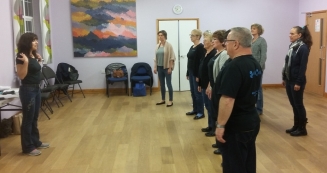Add a comment
Strictly Frisson
‹-- PreviousNext --› I’m amalgamating my write-ups of Thursday evening’s and Friday morning’s coaching sessions because I’m just coming into a bit of a busy patch, and if I blogged about each of September’s adventures separately I might not catch up with myself until November! And it makes a certain amount of sense to consider my visits to Strictly A Cappella and Frisson together, since all of the latter are members of the former, and we found ourselves dealing with some overlapping themes between the two sessions.
I’m amalgamating my write-ups of Thursday evening’s and Friday morning’s coaching sessions because I’m just coming into a bit of a busy patch, and if I blogged about each of September’s adventures separately I might not catch up with myself until November! And it makes a certain amount of sense to consider my visits to Strictly A Cappella and Frisson together, since all of the latter are members of the former, and we found ourselves dealing with some overlapping themes between the two sessions.
Readers with good memories may remember that I worked with both these ensembles back in July. (And, totally coincidentally, that trip also continued on down to Devon to work with Red Rock chorus – but more of that anon.) And two months is long enough to hear a difference in a group that has been working on consolidating the work done in a previous coaching session.
We were looking at a different set of songs from my previous visit, and several of the ideas we worked on then had already been applied to these pieces. In particular, the work we had done on cleaning out the textures to allow the intricacies through, was well-embedded, producing in particular much more nuanced and sophisticated basslines than previously. The use of changing textures across a form to sculpt expressive shape was also clearly in evidence.
One theme we explored last time revisited with both groups on this visit was the use of instrumental timbres to bring a cappella textures to life. It’s not that the music wants direct imitation of instrumental sounds - though of course there is a rich tradition of this as a novelty feature of popular a cappella styles of the last century. Rather, the point is to exploit the huge range of timbral possibilities of the human voice without sounding too much like singers.
We explored things like the distinctive percussive attack of a piano or a bass guitar, the distinction between a real flute and a synthesised flute and its effect on phrasing, and how starting a cello phrase on an up-bow gives a sense of arrival at the second bar on the bow change.
I love working with instrumental metaphors for all kinds of reasons. They offer a shared imaginative world that is both readily accessible to all and full of concrete sensory detail. They invite singers to engage their musical breadth and depth of musical experience in the act of singing, whilst simultaneously organising disparate individuals into a coordinated ensemble soundworld. And I love the way that the singers responsible for the melodies to be accompanied by such instrument-evocatiive textures respond by adapting their vocal timbres to this shared musical environment.
Another theme that emerged several times with Strictly and a couple of times also with Frisson was embedding motivic phrases into longer arcs of musical time. The expressive contexts were quite varied, but all had in common a musical sentence that was made up from a short musical idea (3 to 5 notes long), repeated either exactly with varied harmonisation, or repeated sequentially.
These kinds of phrases can trap you into focusing on the local moment, the beat-to-beat or the bar-to-bar range of musical discourse. But once you start linking them up into longer-range spans of musical time, you find a more varied and organic expressive shape emerging naturally, and with it a clearer sense of the song’s emotional journey.












